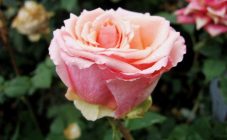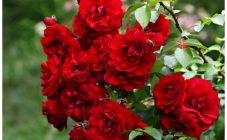Content:
Climbing roses belong to the genus Rosehip. They are widely used in the field of vertical gardening. Flowers are often used to create a variety of garden designs: gazebos, arches, columns or garlands. Rosa Baroque also belongs to climbing varieties and is in rather high demand from gardeners.
History
Baroque (rose barocco or baroque) is a style characterized by decorativeness and whimsy. Rose Baroque, or Baroque (in the German style), fully corresponds to this name.
Breeding work on the creation of the Baroque looped rose was successfully completed in 1999 by specialists from the Tantau nursery located in the northern part of Germany. Due to its original appearance and excellent aesthetic characteristics, the variety almost immediately attracted the interest of gardeners in many countries.
Characteristics of the variety
Rose Baroque belongs to the series of so-called nostalgic roses. The variety can be grown both as a bush crop and as a climbing crop. The flower grows well in containers.
The height of the plant is small for climbing roses - it grows no more than 2 meters in length.
The flowers of this variety are amazingly beautiful. Their color is yellow, but when burned out, the color turns into an amazing creamy yellow shade with an admixture of apricot and salmon tones.
The shape of the flower is cup-shaped, densely double. The number of petals can vary from 65 to 75. Up to three buds can bloom on each of the shoots at the same time. The diameter of each flower is about 10-12 centimeters. The flowering of the plant is quite abundant, re-flowering.
Leaves are glossy, dark green. The aroma of rose is sweetish with insignificant spicy notes.
Baroque roses are frost-resistant and highly resistant to all kinds of diseases.
Features of agricultural technology
Like any other garden culture, the Baroque rose requires some care. To grow a flower crop, the first step is to properly prepare the planting material and choose the right place for planting. Pay attention to the level of illumination of the site and the availability of sufficient space to organize a reliable winter shelter. The place should be well ventilated and at the same time protected from drafts.
Planting a culture is done as follows:
- dig a hole of sufficient size for the free placement of the root system of the seedlings;
- a drainage layer is organized at the bottom;
- pour soil pre-mixed with compost or humus;
- the seedlings are dipped for a while in a container with water (to drink the roots with moisture);
- cut off all shoots, leaving only 3-4 stems, which, in turn, are shortened by about 25 centimeters;
- the seedling is lowered into the hole, carefully straightening the roots, placing the plant in such a way that the root collar is located about 4 cm below the surface of the earth;
- the landing site is covered with soil and carefully compacted;
- abundant watering is performed.
For reliable protection of the root system from drying out in the spring and from cold weather - in the autumn, the rose bush is spud. In spring, hilling must be removed as soon as the first shoots begin to appear.
In a constant mode, it is necessary to monitor the condition of the soil - it should not be either too dry or too wet.
Fertilizing the culture requires regular. In spring, before the buds swell, nitrogen fertilizers are usually applied, which accelerate the development of both foliage and shoots. In summer, mineral compositions are more appropriate, as well as organic mixtures - their use improves the quality of flowering. In autumn, one of the measures to prepare for winter is to increase the plant's immunity and its frost resistance with the help of phosphorus-potassium fertilizers.
The health of the Baroque rose also needs attention. For the prevention of plants, it is recommended to spray with the help of special compositions for the treatment of roses. Insect control is carried out using insecticides.
For the cold period of time, roses must be covered. To do this, after hilling the planting site, the shoots are removed from the support, carefully tied and laid on the ground, previously covered with spruce branches or dry leaves. From above, the roses are covered with the same spruce paws or any non-woven covering material.
The description of caring for Baroque roses does not contain any complex manipulations. Plant care is extremely simple.
Advantages and disadvantages
The Baroque variety has both certain advantages and some disadvantages. The benefits can include the following significant points:
- a good indicator of winter hardiness;
- excellent aesthetic characteristics (a rose will decorate any interior and landscape design);
- ease of care;
- resistance to most diseases;
- suitability for landing on poles;
- unpretentiousness of the plant to growing conditions.
The variety has no significant disadvantages. Most gardeners leave extremely good reviews about Baroque roses. Some flower growers are dissatisfied with the unusual aroma of flowers. Some say it lacks the freshness typical of rose crops. The scent of Baroque roses is a spicy blend with notes of coriander, cinnamon and cloves.
All in all, the Barock rose is an excellent variety, well worthy of the attention it deserves.















